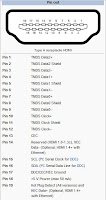

HDMI Versions History & Specification
HDMI devices are manufactured to adhere to various versions of the specification, in which each version is given a number, such as 1.0, 1.2, or 1.3a.Each subsequent version of the specification uses the same kind of cable but increases the and/or capabilities of what can be transmitted over the cable. A product listed as having a HDMI version does not necessarily mean that it will have all of the features that are listed for that version, since some HDMI features are optional, such as Deep Color and xvYCC (which is branded by Sony as "x.v.Color").Note that with the release of the version 1.4 cable, the HDMI Licensing LLC group (which oversees the HDMI standard) will require that any reference to version numbers be removed from all advertising from the cable only. Non-cable HDMI products starting on January 1, 2012 will no longer be allowed to reference the HDMI number and will be required to state which features of the HDMI specification the product supports.
Version 1.0 to 1.2
HDMI 1.0 was released December 9, 2002 and is a single-cable digital audio/video connector interface with a maximum TMDS bandwidth of 4.9 Gbit/s. It supports up to 3.96 Gbit/s of video bandwidth (1080p/60 Hz or UXGA) and 8 channels LPCM /192 kHz /24-bit audio. HDMI 1.1 was released on May 20, 2004 and added support for DVD-Audio. HDMI 1.2 was released August 8, 2005 and added support for One Bit Audio, used on Super Audio CDs, at up to 8 channels. It also added the availability of HDMI Type A connectors for PC sources, the ability for PC sources to only support the sRGB color space while retaining the option to support the YCbCr color space, and required HDMI 1.2 and later displays to support low-voltage sources. HDMI 1.2a was released on December 14, 2005 and fully specifies Consumer Electronic Control (CEC) features, command sets, and CEC compliance tests
Version 1.3
HDMI 1.3 was released June 22, 2006 and increased the single-link bandwidth to 340 MHz (10.2 Gbit/s). It optionally supports Deep Color, with 30-bit, 36-bit, and 48-bit xvYCC sRGB, or YCbCr, compared to 24-bit sRGB or YCbCr in previous HDMI versions. It also optionally supports output of Dolby TrueHD and DGS � HD Master Audio streams for external decoding by AV receivers. It incorporates automatic audio syncing (audio video sync) capability. It defined cable Categories 1 and 2, with Category 1 cable being tested up to 74.25MHz and Category 2 being tested up to 340 MHz. It also added the new Type C Mini connector for portable devices.
HDMI 1.3a was released on November 10, 2006 and had Cable and Sink modifications for Type C, source termination recommendations, and removed undershoot and maximum rise / fall time limits. It also changed CEC capacitance limits, clarified sRGB video quantization range, and CEC commands for timer control were brought back in an altered form, with audio control commands added. It also added support for optionally streaming SACD in its bit stream DST format rather than uncompressed raw DSD like from HDMI 1.2 onwards.
HDMI 1.3b, 1.3b1 and 1.3c were released on March 26, 2007, November 9, 2007, and August 25, 2008 respectively. They do not introduce differences on HDMI features, functions, or performance, but only describe testing for products based on the HDMI 1.3a specification regarding HDMI compliance (1.3b), the HDMI Type C Mini connector (1.3b1), and active HDMI cables (1.3c).
Version 1.4
HDMI 1.4 was released on May 28, 2009, and the first HDMI 1.4 products were available in the second half of 2009. HDMI 1.4 increases the maximum resolution to 4K � 2K (3840�2160p at 24 Hz/25 Hz/30 Hz and 4096�2160p at 24 Hz, which is a resolution used with digital theaters); an HDMI Ethernet Channel, which allows for a 100 Mb/s Ethernet connection between the two HDMI connected devices; and introduces an Audio Return Channel, 3D Over HDMI (HDMI 1.3 devices will only support this for 1080i), a new Micro HDMI Connector, expanded support for color spaces, and an Automotive Connection System. HDMI 1.4 supports several stereoscopic 3D formats including field alternative (interlaced), frame packing (a full resolution top-bottom format), line alternative full, side-by-side half, side-by-side full, 2D + depth, and 2D + depth + graphics + graphics depth (WOWvx), with additional top/bottom formats added in version 1.4a . HDMI 1.4 requires that 3D displays support the frame packing 3D format at either 720p50 and 1080p24 or 720p60 and 1080p24.High Speed HDMI 1.3 cables can support all HDMI 1.4 features except for the HDMI Ethernet Channel.
HDMI 1.4a was released on March 4, 2010 and adds two additional mandatory 3D formats for broadcast content which was deferred with HDMI 1.4 in order to see the direction of the 3D broadcast market. HDMI 1.4a has defined mandatory 3D formats for broadcast, game, and movie content. HDMI 1.4a requires that 3D displays support the frame packing 3D format at either 720p50 and 1080p24 or 720p60 and 1080p24, side-by-side horizontal at either 1080i50 or 1080i60, and top-and-bottom at either 720p50 and 1080p24 or 720p60 and 1080p24.







No comments:
Post a Comment